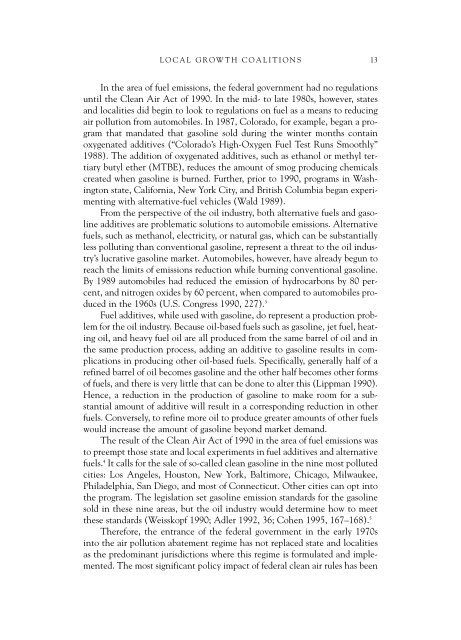GEORGE A. GONZALEZ - fieldi
GEORGE A. GONZALEZ - fieldi
GEORGE A. GONZALEZ - fieldi
You also want an ePaper? Increase the reach of your titles
YUMPU automatically turns print PDFs into web optimized ePapers that Google loves.
LOCAL GROWTH COALITIONS 13In the area of fuel emissions, the federal government had no regulationsuntil the Clean Air Act of 1990. In the mid- to late 1980s, however, statesand localities did begin to look to regulations on fuel as a means to reducingair pollution from automobiles. In 1987, Colorado, for example, began a programthat mandated that gasoline sold during the winter months containoxygenated additives (“Colorado’s High-Oxygen Fuel Test Runs Smoothly”1988). The addition of oxygenated additives, such as ethanol or methyl tertiarybutyl ether (MTBE), reduces the amount of smog producing chemicalscreated when gasoline is burned. Further, prior to 1990, programs in Washingtonstate, California, New York City, and British Columbia began experimentingwith alternative-fuel vehicles (Wald 1989).From the perspective of the oil industry, both alternative fuels and gasolineadditives are problematic solutions to automobile emissions. Alternativefuels, such as methanol, electricity, or natural gas, which can be substantiallyless polluting than conventional gasoline, represent a threat to the oil industry’slucrative gasoline market. Automobiles, however, have already begun toreach the limits of emissions reduction while burning conventional gasoline.By 1989 automobiles had reduced the emission of hydrocarbons by 80 percent,and nitrogen oxides by 60 percent, when compared to automobiles producedin the 1960s (U.S. Congress 1990, 227). 3Fuel additives, while used with gasoline, do represent a production problemfor the oil industry. Because oil-based fuels such as gasoline, jet fuel, heatingoil, and heavy fuel oil are all produced from the same barrel of oil and inthe same production process, adding an additive to gasoline results in complicationsin producing other oil-based fuels. Specifically, generally half of arefined barrel of oil becomes gasoline and the other half becomes other formsof fuels, and there is very little that can be done to alter this (Lippman 1990).Hence, a reduction in the production of gasoline to make room for a substantialamount of additive will result in a corresponding reduction in otherfuels. Conversely, to refine more oil to produce greater amounts of other fuelswould increase the amount of gasoline beyond market demand.The result of the Clean Air Act of 1990 in the area of fuel emissions wasto preempt those state and local experiments in fuel additives and alternativefuels. 4 It calls for the sale of so-called clean gasoline in the nine most pollutedcities: Los Angeles, Houston, New York, Baltimore, Chicago, Milwaukee,Philadelphia, San Diego, and most of Connecticut. Other cities can opt intothe program. The legislation set gasoline emission standards for the gasolinesold in these nine areas, but the oil industry would determine how to meetthese standards (Weisskopf 1990; Adler 1992, 36; Cohen 1995, 167–168). 5Therefore, the entrance of the federal government in the early 1970sinto the air pollution abatement regime has not replaced state and localitiesas the predominant jurisdictions where this regime is formulated and implemented.The most significant policy impact of federal clean air rules has been









